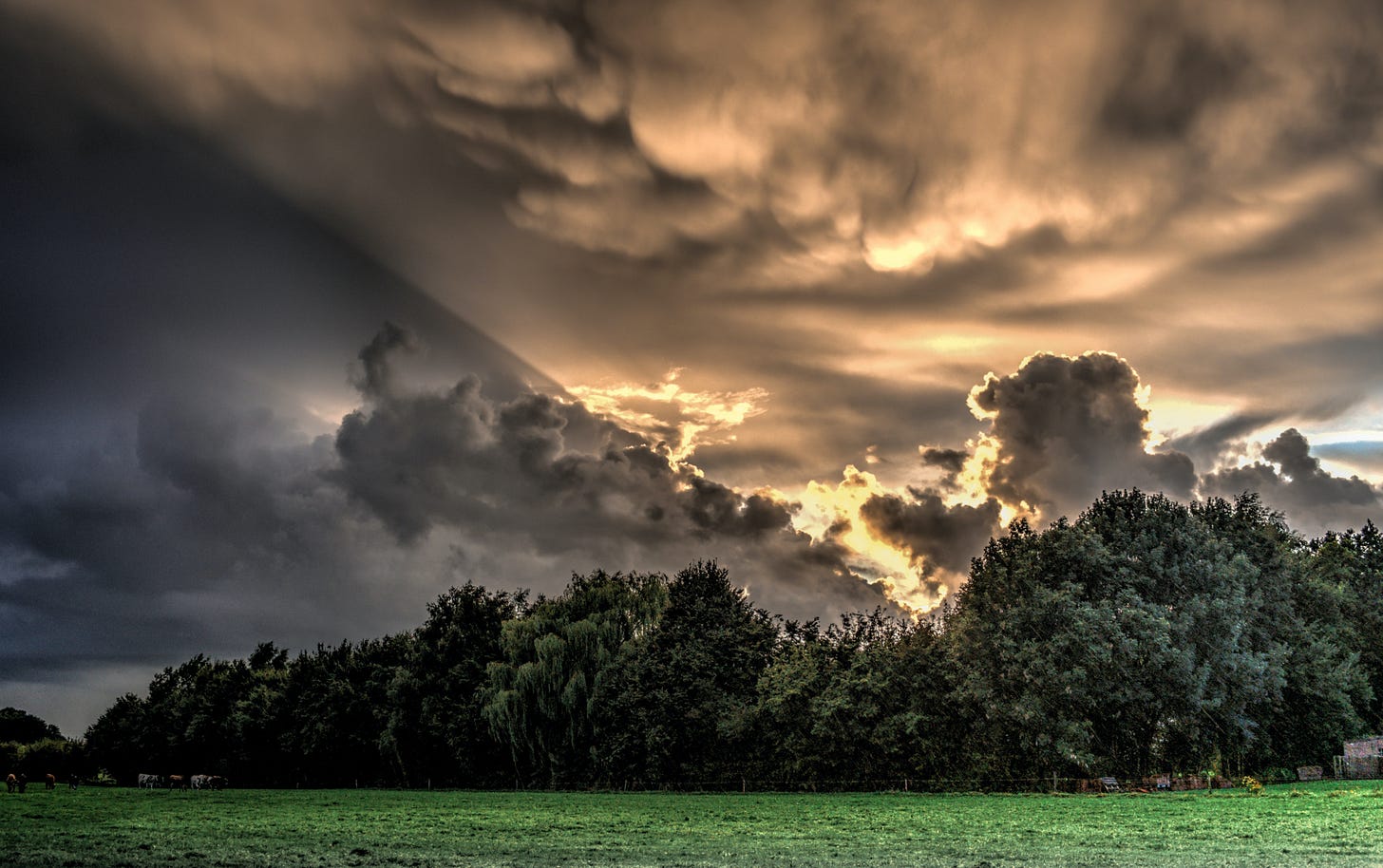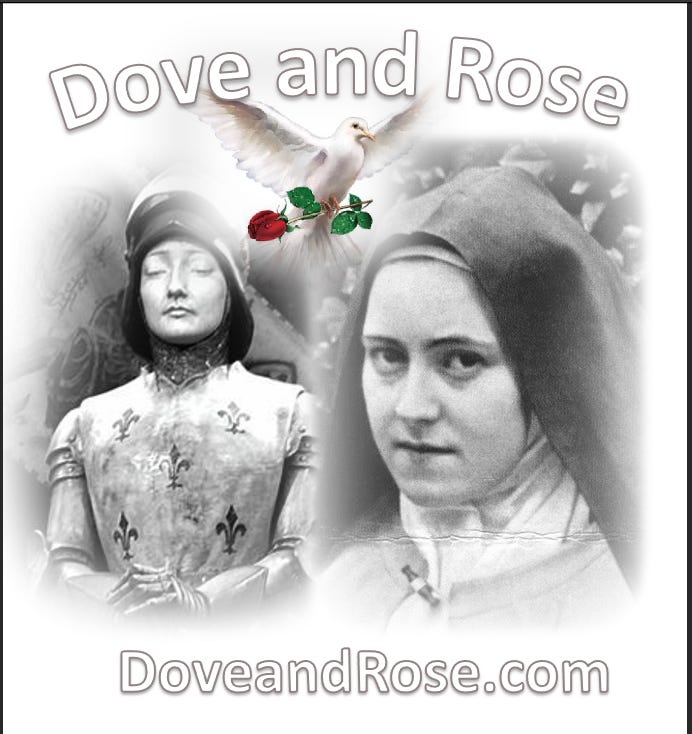Phenomenology and Spirituality
“Our living reality along the lighted pathway in union with St. Joan and St. Thérèse.”
Check out The Dove and Rose podcast here and on Anchor, Spotify, or Apple.
Often when people speak of spiritual phenomena, even those called “mystical,” they are referring to the domain of the natural. Humans are, by nature, spiritual. For purposes of this discussion, spirituality refers to the transcendent capacity of the person to step back from, to rise above, the activities of life to reflect on higher order, more abstract concepts relating to meaning and purpose. It is in the realm of spirituality that one understands the present “now” through the past as projected into the future. Present, past, and future merge into non-linear expressions of time that together manifest the canvas of our lives upon which we paint the “appearance of our existence as it is appearing” in this mysterious, chaotic but substantively teleological process. Becoming aware of the appearance of the appearing in a particular structure of consciousness is an act of spirituality, as is becoming aware of the appearance of the telos, the ultimate purpose, of our existence. Spirituality through non-linear time is consciousness built into the essence of the human person who can actualize that essence over linear time. We are created; yet we are being created.
However, spirituality remains an enigma. It can be difficult to bring together the constituent components of our transcendent experiences to make sense of the order, meaning, and telos of our existence. We have moments of transcendent clarity but often struggle to bring together these moments into a single whole, a “gestalt” image of understanding and transformation. This “problem” with spirituality is not really a problem with spirituality itself but one of intentionality and method. To bring forward the appearance of the gestalt appearing, we must lift our heads from mere day-to-day appearances which we accept with little to no reflection and contemplate intentionally on how the day-to-day presents itself to our consciousness. The world gives itself to us, and it is up to us to receive it as it intends to be received without our inherent biases and pre-conceived notions distorting the transcendent view.
A solution to this problem of a lack of intentionality with others is the phenomenological method whereby we learn to set aside our biases to receive the givenness of the “other” through empathy. Phenomenology can lead to a clearer understanding of that which appears through others as meaning and telos in our own lives. It is a willingness to open oneself to the possibilities of the other. Through phenomenology we can set aside our pre-conceived notions without forsaking them unless we determine through the methodology that they need to be forsaken. Setting aside our biases, we can systematize intentionally how the world appears to our consciousness and build an objective structure of meaning out of our subjective experience. As created beings, we allow ourselves to be created in higher states of consciousness through the transcendent givenness of the gestalt towards which we journey.
Spirituality with phenomenology as a pedagogical methodology for creating the structure of meaning in our lives remains natural despite its transcendent qualities. All human beings are capable of transcendence, phenomenological discovery, and meaningful expression through intentionality and the awareness of the need to see the world not merely as it appears in our mundane activities but as it reveals itself to our consciousness.
There remains, however, a vitally important distinction between spirituality in the natural sense and the experience of spirituality through the supernatural. What some call supernatural often is dismissed merely as an unexplored domain of the natural, for example, an otherwise unknown state of consciousness. Or perhaps the supernatural is an alternative and formerly unknown dimension of natural reality. In these modes, the supernatural is accepted only as a formerly unexamined state of nature and not truly as “super”-natural. However, looking beyond mere appearances and into the heart of what truly is given in the supernatural, we find much to be explored with a sense of awe. The question of just what a supernatural phenomenon is remains open.
The position of this author is that the supernatural is what it gives itself to be which is beyond the natural. It is “of God” who is the creator of nature and not bound by it. The supernatural is not “formerly unexplored nature”; it is an entirely different domain yet one capable of revealing itself in the natural. It requires of us not a leap of faith but simply an openness to receive it. Making sense of the supernatural experience usually is helped by looking systematically at the phenomenon through the lens of a religious hermeneutic. The religious hermeneutic provides one with a sense of who is the God of the “of-God” supernatural experience. It gives one definition and context, even if only one context of many. It helps us understand what we are receiving.
One could argue that the religious claim to revelation as a means of supernatural hermeneutical insight and discovery is, in fact, the very bias that the phenomenological method warns against. However, the position of this author is that religious context, that is, the framing of the phenomenon in a particular religious tradition, could be the very pathway through which the mysterious world of the supernatural becomes accessible. If the phenomenon gives itself as an essence within a particular tradition; then, that tradition might be the pathway to understanding the phenomenon. Far from being a bias, the religious context can be a conduit, a path, or a trail that reveals the very systematic structure derived by the phenomenon’s essence. In other words, religion can be revelatory, which is precisely what it gives itself as being.
The revelatory character of Catholicism is the religious context framing The Dove and Rose and the associated phenomenology of St. Joan of Arc and St. Thérèse of Lisieux. It is through the lens of Catholicism that the combined hearts of St. Joan and St. Thérèse give themselves as the Kingdom Blessed in the center of the Immaculate Heart of Mary. It is through the lens of Catholicism that the Jehannian hermeneutic imbued in the poetry and plays of St. Thérèse brings to light the appearance of that which is appearing as the Kingdom of Catholic and Royal France in the center of the Immaculate Heart of Mary. It is through the lens of Catholicism that we come into Our Lady’s Kingdom as a royal line of St. Mary Magdalene’s House of New Bethany.
The Dove and Rose is revealed through the heart of St. Joan of Arc as her heart is interpreted by St. Thérèse. It is a supernatural phenomenon contextualized and therefore manifested in its true givenness through the revelatory lens of Catholicism. The Dove and Rose is a phenomenological explanation of the supernatural experience of the combined hearts of St. Joan and St. Thérèse.
The reader will find in these pages a series of models and essays that flow in the order intended by the author. The connection between each may not always be apparent. The synthesis of all chapters into a unified whole of meaning is left by necessity to the reader who must follow their own phenomenological process through the syntax of supernatural grace working in their lives.



